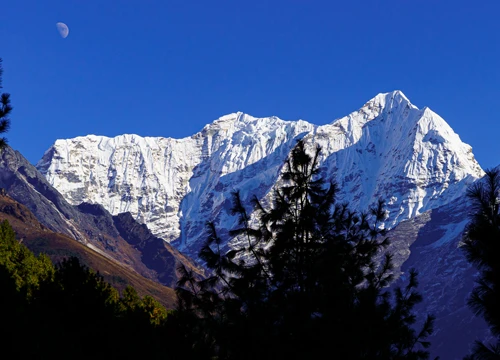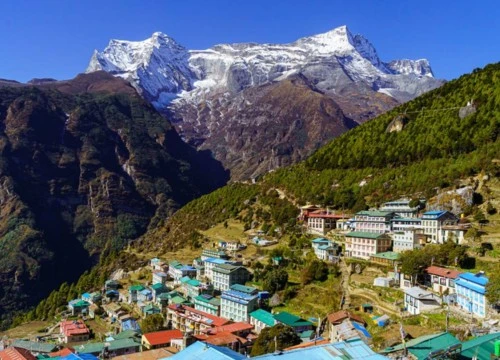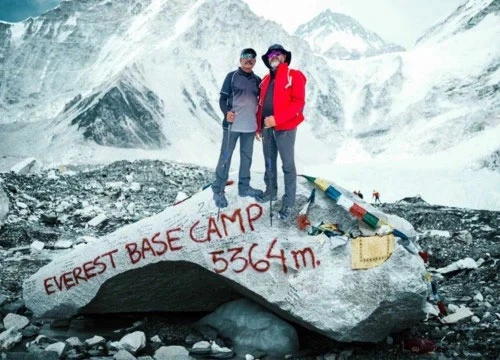How to prepare for Everest Base Camp helicopter tour?
The trek to Everest Base Camp is a challenging yet rewarding adventure that requires a detailed plan. You can prepare for the trek by doing the following things:
- Get in Shape: The trek to Everest Base Camp entails trekking for several hours each day and climbing across steep terrain, so physical fitness is required. Begin a training program that involves both cardiovascular (running or cycling) and strength training (such as squats and lunges).
- Acclimatize: The Everest Base Camp is located at an elevation of around 5,380 meters (17,600 feet), which is far higher than most people are accustomed to. Allowing your body time to acclimate to the high altitude can help reduce the risk of altitude sickness. Before beginning the trek, consider spending a few days in Kathmandu (1,400 meters/4,600 feet) or Lukla (2,800 meters/9,200 feet).
- Pack wisely: The weather in the Himalayas may be inconsistent, with temperatures varying from pleasant during the day to bitterly cold at night. Bring layers of clothing that you can easily add and remove, as well as a warm cap, gloves, and a sturdy pair of hiking boots.
- Get Vaccinated: Some vaccines, such as those for hepatitis A, COVID-19, and typhoid, are advised for visitors to Nepal. To establish whether medicines are appropriate for you, speak with a healthcare provider or a travel clinic.
- Travel insurance: It is important to get travel insurance that covers medical emergencies and evacuations, as these can be costly in the event of an emergency on the trek.
- Hire a trustworthy trekking agency: Holiday Tours Nepal is a trust worth providing employment opportunities to the local guide for the journey to the Everest Base Camp. Local guides can provide useful information about the route, local culture, and safety, as well as assist you in adjusting to the high altitude. Holiday Tours Nepal provides a reliable guide with prior experience leading treks in the area.
Permits Required for Everest Base Camp Trek with Helicopter Return
Trekking to Everest Base Camp requires a few essential permits to ensure safe and authorized travel through the Khumbu region. These permits help support local communities, maintain trail infrastructure, and conserve the natural environment. When you book with Holiday Tours Nepal, we handle all permits on your behalf for a smooth and hassle-free experience.
Mandatory for all trekkers entering the Khumbu region.
Issued at Lukla or at the entry point in Monjo.
Cost:
NPR 2,000 per person for Nepali citizens
NPR 6,000 per person for foreigners (approx.)
Replaces the old TIMS Card for this region.
Required to enter Sagarmatha National Park, home to Mt. Everest.
Can be obtained in Kathmandu (Bhrikutimandap) or at the Monjo Checkpost.
Cost:
NPR 3,000 per person for foreigners
NPR 1,500 for SAARC nationals
NPR 100 for Nepali trekkers
Climate and weather conditions
The weather can be particularly cold and dry during the winter (December to February), with temperatures plunging well below freezing at night. At higher elevations, snow is frequent, and the trails can be slick and difficult to walk.
The summer (June to August) is the monsoon season in Nepal, and the region is prone to heavy rainfall and thunderstorms. The trails may be muddy and slippery, and the risk of landslides is higher.
At the Everest Base Camp (5,380 meters/17,600 feet), the weather is cold and dry, with temperatures ranging from -10 to 10 degrees Celsius (14 to 50 degrees Fahrenheit) during the day and dropping well below freezing at night. It is important to bring layers of warm clothing and be prepared for changes in the weather.
Accommodation facilities
Holiday Tours Nepal provides the best tea houses that have private attached bathrooms, electric blankets, warm rooms, and hot water bags to place inside the sleeping bag in case of electricity unavailability.
The accommodation facilities on the trek to Everest Base Camp are basic and may not be the same as what you are used to at home. It is important to remember that you will be in a remote and rugged environment, and the facilities will reflect this.
We provide rooms with electric blankets and attached bathrooms. These types of lodges are not luxurious lodges, but they are comfortable lodges compared to normal and basic lodges and are warm and comfortable. Places like Phakding, Namche, Tengboche, Debouche, and Dingboche offer these facilities. For the last two days at Gorakshep and Lobuche, attached bathrooms have not been available, but electric blankets are available, which work through solar panels. In case the blankets are not working, we provide hot water bags to all the clients and trekkers.
Best hotels for everest base camp trek with the best facilities are mentioned below. We will be using this hotel during our Everest Base Camp trek.
- Phakding - Yeti Mountain home
- Namche - Yeti mountain home
- Debuche - Culture home
- Dingboche - Dingboche Resort
- Lobuche - Oxygen Altitude Home
- Gorakh shep - Hotel Everest Inn

Washing and toilet facilities at Everest
In the lodges, you have access to private attached bathrooms. These amenities may be simple and straightforward, lacking hot water and toilet paper. Some lodges offer hot showers for which the tea houses charge extra.
It is important to remember that the facilities on the trek may be basic and may not be the same as what you are used to at home. It is a good idea to bring your own toilet paper and hand sanitizer and to be prepared for the possibility of taking cold water showers.
Note in Lobuche and Gorakshep due to lack of availability there may be limited room and sometimes a place in higher elevation may be packed due to which attached rooms may not be available.
Culture and Religion seen at the trail of Everest Base Camp
Sherpa people, a Tibetan Buddhist minority renowned for their strong mountaineering history, live in the Everest Region. The sherpas have a strong cultural and spiritual connection to the mountains, and they play an important part in the region's tourism economy.
You will have the opportunity to learn about Sherpa culture and their way of life during your climb to Everest Base Camp. Along the walk, you may witness prayer flags, Mani walls (walls adorned with stone tablets inscribed with the mantra "Om Mani Padme Hum"), and chortens (stupas), all of which are key parts of Tibetan Buddhist culture. In the villages, you may also come across monasteries and thakhangs (little temples), which are frequently utilized for prayer and meditation.
The Sherpas are polite and welcoming people who will be delighted to share their culture and customs with you. When visiting temples and monasteries, it is important to be respectful of their culture and religion, as well as to follow local customs and traditions.
Why is travel insurance necessary for Everest Heli Tour?
Travel insurance is necessary for your Everest Base Camp trek to protect against unforeseen situations such as medical emergencies, evacuations, trip cancellations, and lost or stolen luggage.
When choosing a travel insurance policy, be sure it includes coverage for high-altitude treks as well as emergency medical and evacuation coverage. Consider obtaining trip cancellation and interruption coverage in case you need to cancel or shorten your vacation due to unforeseen circumstances.
Some points to look for in a travel insurance policy for Everest Base Camp Trekking with Helicopter Return include:
- Medical Coverage: Choose a policy that provides coverage for medical emergencies, including altitude sickness and other illnesses that may occur during the trek.
- Evacuation coverage: Choose a policy that provides coverage for evacuations by helicopter or other means in case of a medical emergency or other unforeseen event.
- Trip cancellation and interruption coverage: Choose a policy that provides coverage in case you need to cancel or cut your trip short due to unforeseen circumstances, such as a medical emergency or a natural disaster.
- Baggage coverage: Choose a policy that provides coverage for lost, stolen, or damaged luggage.
It is important to read a copy of your travel insurance policy to understand what is and is not covered. It is also a good idea to consult with a travel agent or a travel insurance specialist to determine the best policy for your needs.
How is rescue done during Everest trek?
There are two types of policies. The first one is in which the trekkers pay first and get paid back by the insurance company, and the other is in which the insurance company pays up all the amount upfront.
For rescue, the helicopter charges $5500 for chartering it from Everest Region to Kathmandu. Then, from the airport, the trekkers are taken to the hospital in an ambulance, and the doctors and nurses take over from there. The patient is kept in the hospital for observation and treatment and is discharged when the hospital gives discharge clearance.
Altitude sickness during Everest base camp trek with Helicopter return.
Altitude sickness, also known as Acute Mountain Sickness (AMS), is a common disease caused by rapid ascends in high altitudes. Headache, nausea, vomiting, exhaustion, and difficulty sleeping are all symptoms of AMS. In severe circumstances, AMS can develop into life-threatening diseases such as High-Altitude Cerebral Edema (HACE) and High-Altitude Pulmonary Edema (HAPE).
As you ascend higher in altitude, the danger of altitude sickness grows, and it is a concern for trekkers and climbers on the Everest Base Camp journey, as the base camp is located at a height of roughly 5,380 meters (17,600 feet). To lessen the risk of AMS, allow your body time to acclimate to the high altitude by gradually ascending and taking rest days as needed. While at high elevations, it is also important to stay hydrated and avoid alcohol and smoking.
If you have AMS symptoms, you should descend to a lower altitude as soon as possible and seek medical assistance if they do not improve. Medications may be used to help prevent or treat AMS in some circumstances.
If you have a history of AMS or other medical issues, you should visit a doctor before embarking on a Journey to Everest Base Camp. Your doctor can advise you on whether the trek is safe for you and give tips for preventing or managing AMS
Holiday Tours Nepal Exercise and preparation routine for attempting Everest base camp trek
Week | Focus areas | Activities | Details | Remarks |
Week 1-2 | Building base for the trek | Cardio, strength and flexibility | Cardio: 3-4 days/week: Brisk walking, cycling, or jogging (45-60 minutes)
Strength: 2-3 days/week: Squats, lunges, step-ups, planks (3 sets of 12-15 reps)
Flexibility: Stretching or yoga (20 minutes after each workout) | Helps to build the base that will help for building endurance and stamina. |
Week 3-4 | Strengthening the Legs | Hiking, Strength, Core | Hiking: 2-3 days/week: Hike on an incline or treadmill (1-2 hours). Start carrying a light pack (5-10 lbs.)
Strength: 2-3 days/week: Squats, lunges, step-ups with weight (10-15 lbs.)
Core: Planks, leg raises, Russian twists (3 sets of 20 reps) | Helps to develop strength and make the legs stronger which will help for the hike during the trek. |
Week 5-6 | Increasing Intensity | Endurance, Weight Training, Hiking | Hiking: 2-3 long hikes (3-4 hours) with weight (10-15 lbs.). Focus on incline and rocky terrain
Cardio: Running or cycling for 45-60 minutes (2-3 times/week)
Strength: Weighted squats, lunges, step-ups, core work (3 sets of 12-15 reps each) | Helps to build further endurance |
Week 7 | Endurance & Simulation | Long Hikes, Full Body Strength | Long Hikes: 1-2 long hikes (5-6 hours) with heavy pack (15-20 lbs.), focus on uphill and varied terrain. Include stairs if possible
Strength: Full body exercises (weighted squats, lunges, step-ups, planks)
Core: 3 sets of planks, side planks, mountain climbers | Helps for building endurance for long hikes and helps for stamina. |
Week 8 | Peak Intensity & Recovery | Simulation, Light Cardio | Simulation: 1 long hike (6-7 hours) with a full pack, focus on staying hydrated and fueled
Cardio: Light running or cycling (30-40 minutes)
Recovery: Stretching, yoga, light walking for flexibility and muscle relaxation | Helps for stretching, flexibility and preparation before and after hike |
Week 9 | Breathing training | Nose and mouth breathing patterns. | Box to box breathing, navy breathing, nasal breathing, belly breathing, 4-7-8 breathing, pursed lip breathing, coherent breathing, bhastrika breathing | Helps for breathing in high altitudes |
Tips for trekkers who are trekking in the Himalayas
- Build stamina, practice hiking and do some hikes that involves altitude to know how your body would react in high altitude.
- Let the loved ones know that you’re traveling to your family or loved ones and let them know about the agency that you’re traveling with.
- Stay connected, share your itinerary, respect local customs and be honest with the guide and let them know if you’re not feeling well
- Stay hydrated and nourished in the mountains and remember food is fuel if you stop consuming food remember your going to fall sick or lose energy so don’t stop eating.
- Be patient stay positive and trust your instincts and remember in altitude sometimes you feel angry and can have secondary thoughts.
- Check the weather forecast or ask the guide about the weather and what to wear.
- Respect local traditions, leave no trace, use eco friendly products and keep the trails clean.
- Keep the money, document and important documents safe
- Keep the power bank, cameras and electronics safe and at night try to cover the electronics with clothes so they stay warm and don’t drain the battery.
Tips for Female Trekkers
- Know your cycle and pack accordingly sanitary pads, period underwear’s, menstrual cups and tampons.
- Pack sanitary pads in case sometimes the dates can be up and down and even someone might need in trek in case you don’t use it.
- Bring pain relivers like ibuprofen, heat patches, to ease cramps stay hydrated and eat good nutrition food.
- Wear comfortable and food layered clothing’s rest when needed and mind your mood.
Equipment and Gear List
 General
General
- Four-season (-20 degree) sleeping bag (We provide rental sleeping bags available for an additional USD 35)
- Puffy down jacket (We provide rental jackets for an additional USD 35)
- Daypack (25-30 liters recommended) with rain cover
 Upper Body
Upper Body
- Sun hat or cap (We'll provide you with a trekking cap.)
- Warm woolen hat
- Scarf/Neck Buff (highly recommended to get saved from wind and cold)
- Headlamp or mobile torch light for nighttime
- Polarized sunglasses
 Torso
Torso
- Technical fabric base layer thermals are light for warmer months, heavy for colder months
- Technical fabric t-shirts and sleeve sweaters or high-necks
- Waterproof rain jacket
- Windproof jacket for the walk as it gets windy
- Fleece jacket or down jacket
 Lower Body
Lower Body
- Thermals inner
- Hiking pants at least 3
- Comfortable pants for teahouses
- Waterproof, windproof shell
- Hiking shorts
 Hands
Hands
- Woolen gloves for the tea house
- Hard-shell windproof outer gloves for the walk
 Feet
Feet
- Marino Wool or comfortable, warm socks
- Hiking socks
- Liner socks
- Trekking/hiking boots (waterproof recommended)
- Crampons (For passes)
- Casual shoes or sandals that are comfortable for the time in the tea house
- Gaiters (lightweight for rain and snow)
 Undergarments and Inner Wears
Undergarments and Inner Wears
- Technical fabric/quick drying (can be washed during the trek)
- Sports bras (women)
- Sleeping clothes as per the comfortability
 First Aid Kits and Medications
First Aid Kits and Medications
Note: Our guides carry medications, oxygen cans, and first aid kits during the trip. However, personal kits and medications are recommended.)
- Sunscreen SPF- 50+
- Lip balm or Vaseline
- ointment cream
- Cough Syrup and strepsils (recommended for Khumbu Cough)
- Creams and medicines (for any allergies or diseases)
 Other Essentials
Other Essentials
- Passport
- Extra copies of passport-sized photos
- Reusable water bottle
- Toilet paper, small soap, and shampoo
- Water purification tablets or UV water purifier (if you plan to treat water)
- Water bladder for the day bag
- Small towel for personal use
- Pillowcase in case of allergies to new pillows
- High-protein snacks (such as mountain bars or nuts)
- Waterproof/dry bags for carrying essential documents, stuff, frequently used items, and money
- Power bank or extra batteries
- Cameras and mobile phone
- Cards/book
- Pee bottle/ pee funnel for women
- Trekking poles
- Whistle in case your voice is not loud enough to stop or start
- Thermos for hot water during the nighttime
- We give you a free duffel bag, trekking cap, maps, and t-shirt during your pre-trip meeting in Kathmandu. The duffel bag will be used to pack your trekking supplies.
- For every two participants, we assign one porter. The porter will carry the duffel bag, which should weigh around 10 kg/22 lbs., throughout the walk.
- Daypack bag for daily used stuff like cash, documents, papers, a water bottle or bladder, a camera, toiletries, sunscreen, a notebook, clothing, etc. (with a waterproof cover).
- You can store your luggage (on-trekking items) at the hotel in Kathmandu, and we can assist and help.
- Total luggage for the Kathmandu-Lukla flight is (15 kg/33 lbs.), including duffel (10 Kg/22 lbs.) and backpack (5 kg/11 lbs.)
- A down jacket with a hood(cap) to be warm in altitudes above 3,000m.
- We can provide a down jacket for USD 35. In case of loss or damage, you need to pay back the cost of USD 200 per item.
- We can provide a sleeping bag for USD 35. In case of loss or damage, USD 200 per item must be paid.

Note: Supplies and gear can be rented or purchased in Kathmandu. Once you are in Nepal, you can buy supplies and gear for hiking if you have spare time. Holiday Planner Nepal representatives will assist you in purchasing the equipment. Thamel a tourist hub, offers a wide range of trekking equipment at affordable prices. Don't wear short clothes inside the monasteries and religious places.
Tips for responsible tourism and respecting local culture at Everest region
- Walk through the left.
- Dress modestly wears long clothes.
- Be polite and engage with the locals with a respect.
- Avoid flashy displays be modest with wealth, technology and the body.
- If someone or someplace deserves a donation show case your love for the community.
- Don't shoot videos and photos inside the monasteries.
- Don't keep your feet over the mantra engraved stones.
- Respect the locals.
- Ask permission before taking pictures.
- Hire the local trekking agencies.
- Buy and support locals by using their local products.
- Avoid leaving trash or any waste behind and carry your waste to the designate bins.
- Avoid the use and throw of plastic bottles on the trail fill up you bottle and throw the bottle in the designated bins.
- Do not pick plants or disturb the wildlife.
- Don’t take things from the nature.
- Limit the use of fire woods and conserve the water. (woods cannot be used for fire)
Charging Ports and plugs available in Nepal
- Use an adapter that uses types D, C, and M. Universal multi plug adaptor is acceptable as well.
- Charging costs extra in the mountains, and the cost varies according to the place.
- Bring a power bank of at least 10,000 Mah.
- Leave your power bank on charge rather than the smartphone.
- Phones must be charged at reception where the multiplugs are.
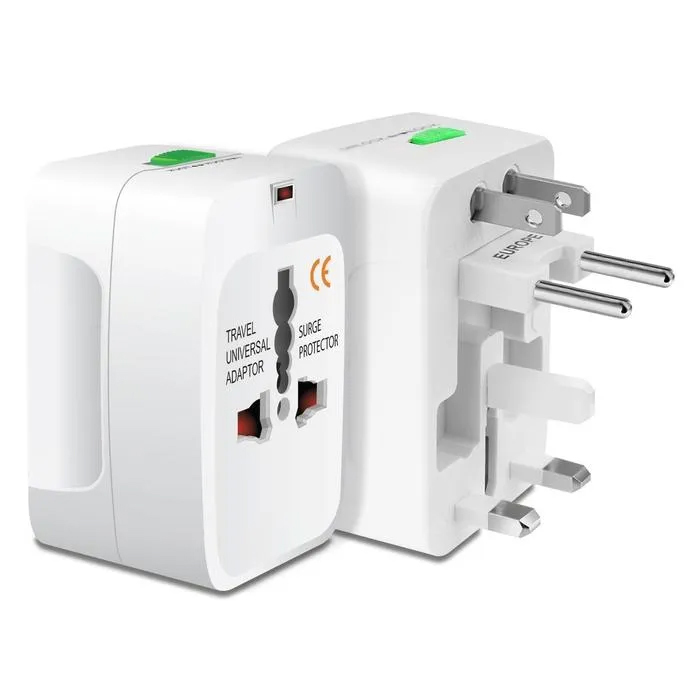
Advantages of planning your trip with us
- Pick-up and drop-off services for all passengers upon international arrival and departure.
- Well-trained, experienced, fluently English-speaking guide, and a strong sherpa or porter for carrying the duffel bag.
- Welcome dinner upon arrival with cultural Nepali dances.
- Three meals a day and tea or coffee during the trek, with accommodation in the mountains.
- First-aid kit box and first-aid services.
- We provide Holiday Planner Nepal’s maps, t-shirt, and cap.
- Down jackets and sleeping bags are available for rent.
- We organize custom services as per the requests of our clients.
- Arrangement of emergency evacuation service (must be paid by the client or insurance).
- We provide an oximeter to check your pulse, oxygen saturation, and heart rate.
- We provide oxygen cans during high-altitude treks.
- We provide SIM cards for travelers, so there won’t be any communication issues.
The Everest Base Camp Trek with Helicopter Return is the perfect blend of adventure, comfort, and time efficiency—ideal for trekkers who want the full Everest experience without the long return hike. This trek lets you walk through iconic Sherpa villages, stand beneath the mighty Everest, and enjoy a luxury helicopter flight from EBC back to Kathmandu or Lukla, offering breathtaking aerial views of the Khumbu Glacier, Ama Dablam, and the entire Everest region. With added convenience, safety, and a shorter itinerary, this package has become one of the most popular Himalayan adventure trips for all types of travelers.
Whether you’re seeking an unforgettable Himalayan journey, limited on time, or simply prefer a scenic and comfortable return, the Everest Base Camp Heli Return Trek delivers an unmatched experience.
Ready to turn your Everest dream into reality?
Book your Everest Base Camp Trek with Helicopter Return today with Holiday Tours Nepal and enjoy a safe, scenic, and expertly guided adventure in the heart of the Himalayas.



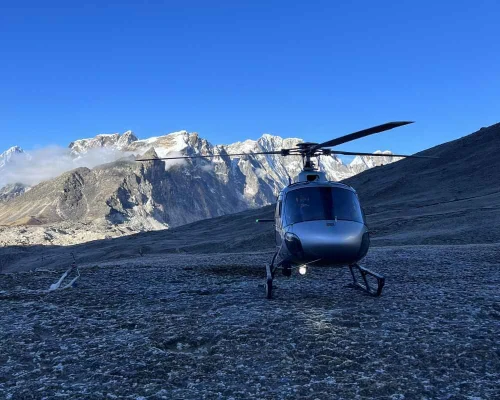
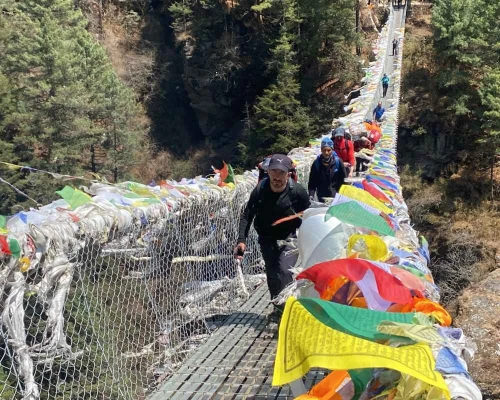
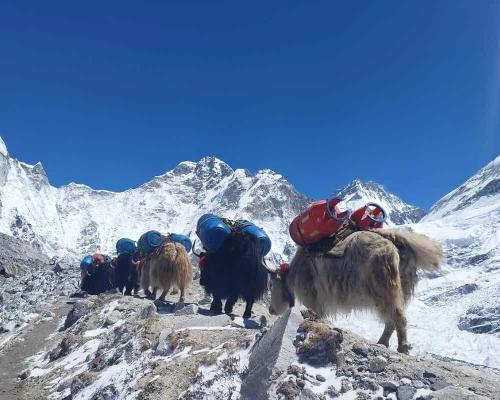


 General
General Upper Body
Upper Body Torso
Torso Lower Body
Lower Body Hands
Hands Feet
Feet Undergarments and Inner Wears
Undergarments and Inner Wears First Aid Kits and Medications
First Aid Kits and Medications Other Essentials
Other Essentials


